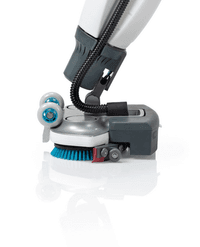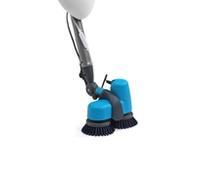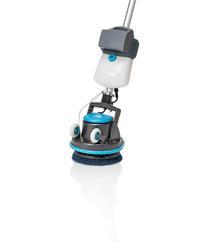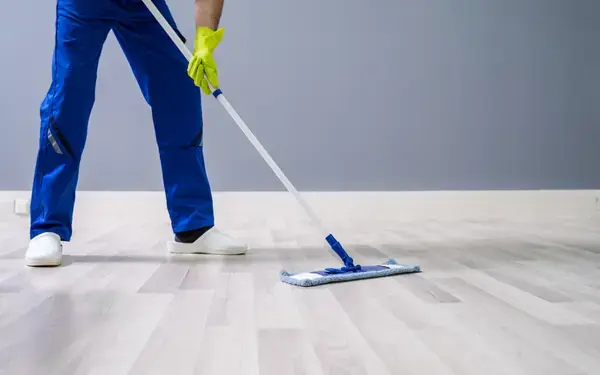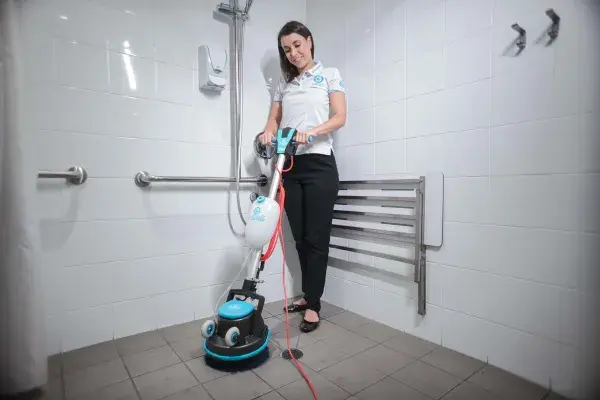You are reading: How to Detail Clean Corners, Edges & Grout with the i-Scrub 21B Small Commercial Floor Scrubber
09 July 2025
8min read time
Brooke Payne
How to Detail Clean Corners, Edges & Grout with the i-Scrub 21B Small Commercial Floor Scrubber
Share:

Key Insights
- Corners, grout lines, and edges are often the first areas to show dirt and mildew—yet they’re the most commonly missed during routine cleaning.
- Manual scrubbing is inconsistent and time-consuming; a compact tool like the i-scrub 21B delivers consistent results in half the time, especially in tight or awkward spaces.
- A structured detail-cleaning routine—daily sweeping, weekly scrubbing, and monthly deep cleans—keeps hard-to-reach areas clean and inspection-ready.
Every professional cleaner or facility manager has been there: your team member finishes a “thorough” floor clean – but they've missed the dust and grime lurking in corners, edges and grout lines. Tiny crevices hide dirt that standard mops and machines can’t reach, leaving grout dirty and baseboards grimy despite your best efforts.
In high-traffic schools, gyms or hotels (and even homes!) those overlooked spots are glaring to guests and inspectors alike.
In this practical guide we’ll tackle the detail-cleaning challenge head-on. You’ll learn why corners and grout are such trouble zones, proven steps to scrub them clean, and how tools like the compact i-scrub 21B small commercial floor scrubber make the job faster and more effective. By the end, you’ll have a solid plan – from quick pre-treatments to scheduling – to keep every inch of your floors spotless.
Edge Cleaning: The Challenge
Corners, edges and grout lines often work like dirt magnets: standard equipment simply can’t get into every nook. Most commercial floors use hard tiles that resist stains, but the porous grout between them soaks up spills and soil. Over time, grime builds up in the angles and along baseboards – in fact, you’ll often find the first signs of mildew growth are a dark or black discoloration in the corners, edges, and on the surface of the grout. Sweepers and big scrubbers push some debris to edges, but due to there design many struggle to completely remove it.
The result? Hidden soil and buildup affecting appearance and hygiene.
Industry experts note that detailed cleaning – corners, joints, angled parts – is difficult with manual scrubbing alone. In short, without the right methods, corners become the weak link in your facility maintenance.

Proven Techniques for Detail-Cleaning
To conquer corners, edges and grout, a disciplined approach is key. Follow these proven, step-by-step methods:
• Pre-treatment for grout and edges.
Identify the soil and choose the right cleaner. For greasy buildup or heavy soils (common in kitchens or entryways), use a commercial alkaline degreaser. Let it dwell 5–10 minutes to break down oils. For mineral deposits or moldy grout (in showers, bathrooms or locker rooms), an oxygen bleach or acidic tile cleaner may be needed. Always spot-test first. As one expert advises, a good method is to spray with a strong cleaner, allow dwell time (2–3 minutes), and then scrub. This softens the grime so it scrubs away easier.
• Manual tools & accessories.
The right hand tools make a big difference. Use stiff, angled detail brushes or grout scrubbing brushes – like a “V” or corner brush – to work along the wall-to-floor joint and between tile seams. A nylon scrub pad on an extension handle can reach along baseboards without kneeling. Microfiber dust mops and vacuum attachments with crevice tools help remove dry debris from edges before wet cleaning. For very narrow gaps, an old toothbrush or a grout-cleaning pick can reach in. In routines, color-coded equipment (dedicated mop pads or brushes for floors vs. surfaces) avoids cross-contamination. Don’t forget safety: always place wet-floor signs after rinsing.
Book A DemoStep-by-step corner-cleaning process:
- Clear & prep the area. Move furniture or equipment away from walls. Sweep or vacuum thoroughly along all edges and corners to loosen loose debris. (This prevents just pushing dirt around.)
- Apply cleaner to grout/edges. Generously spray your chosen cleaner onto grout lines, baseboards and corner joints. Let it dwell as recommended (often 5–10 minutes). This chemical reaction helps lift embedded dirt and stains.
- Scrub with intent. Using your handheld brush or scrubbing pad, scrub each corner and edge. Work in small sections: focus on a single tile’s grout lines before moving along. A firm back-and-forth motion or circular rub will dislodge soil. For painted coving or stair treads, a soft-bristled brush or even a cloth on a pad is safer. Mechanical scrubbing really pays off here – studies show powered scrubbing “multiplies your effort” on tough soils (This is why a small commercial floor scrubber or edge cleaners can save hours on large jobs.)
- Rinse and extract. After scrubbing, use clean water to rinse or mop up the dirty solution. A wet-vacuum can pull residue right from grout lines and edges if available. Make sure to remove all cleaning solution – residues can re-attract dirt or leave films.
- Inspect & seal (optional). Once dry, inspect the grout. If it looks clean, consider applying a grout sealer. A penetrating sealer will protect grout and make future cleaningseasieras it helps prevent reoccurrence of soiling conditions and makes future cleanings easier and faster.
How often should you clean Edges?
While every facility differs, a good rule is daily + weekly + periodic deep cleans. For example, in restaurants or gyms: sweep and spot-clean edges daily; scrub grout/edges on a weekly schedule; and perform a full degrease and deep scrub monthly. A facilities guide suggests: Daily – sweep and mop fully; Weekly – scrub grout lines and under furniture with a small scrubber; Monthly – full deep clean with power tools.
In schools or hotels, high-traffic hallways may need edge-cleaning every few days, whereas offices might be monthly. Adapt the timing to traffic – high-use floor joints need more attention.
Pro tip: Use a cleaning checklist that specifically lists “corners, edges and grout” to ensure no one skips them.
For a completely comprehensive article on cleaning grout lines click here !
Edge Cleaning with Small Commercial Floor Cleaners
Cleaning tight spaces and stubborn grout is far easier with the right equipment. Manual scrubbing can deliver results, but it’s time and labor-intensive. In contrast, small-purpose machines amplify your effort. Take the i-scrub 21B for example: this lightweight (3.2 kg) battery scrubber was designed for hard-to-reach spots. It packs two counter-rotating 400 RPM brush discs under a slim head. That means when you press down in a grout line, the brushes still spin aggressively without buckling. Add optional stiffer brushes for caked-on dirt, and it turns elbow grease into machine power.
The i-scrub’s true edge is its 360° swivel head and adjustable handle. You can tilt it vertically to scrub walls or stair risers, or horizontally along baseboards – even around toilets. Staff can clean at a comfortable height thanks to the telescopic wand. Battery operation (over 2 hours runtime) lets crews detail multiple rooms on one charge. In practice, teams report that a small scrubber like this eliminates hours of hand-scrubbing in corners, delivering more consistent results than mopping alone. In fact, you’ll find that powered scrubbing “multiplies your effort”, making deep cleaning tasks far quicker.
Take a look at this article here which breaks down The top 6 Floor Mini Scrubbers for 2025 .
Contrast this with traditional methods: an old grout brush can handle part of a tile floor (well.. only the grout line, really) and without power it still relies on user strength.
The i-scrub 21B (and similar compact floor scrubbers) bridge that gap. They fit where larger machines can’t – around toilets, along narrow stair steps, showers and even commercial kitchen spaces while still applying true mechanical cleaning. By integrating such equipment, your facility gains better hygiene and efficiency. Corners and grout lines that once needed knee-brushing can be cleaned in half the time, freeing staff for other tasks and ensuring uniform cleanliness throughout the facility.
Take a look at some of our commercial floor cleaners here: https://i-teamanz.com/products
How to Create a Cleaning Routine with a Commercial Floor Cleaner
Consistency is key. Start by scheduling regular detail-cleaning into your floor-care routine. For example, dedicate one day each week (or twice weekly in busy areas) to deep-scrub corners and edges with the tools above or your small commercial floor cleaner. Put this on your master cleaning calendar or checklist.
Train your team in the new process: demonstrate the step-by-step method, practice on sample areas, and highlight how to use any new equipment (like the i-scrub 21B ) safely. Emphasize the “why” – workers do a better job when they understand that overlooked corners ruin overall cleanliness.
Measure and maintain success with simple audits. Inspect and photograph corners after cleaning shifts to verify results. Checklists can list “baseboards and grout” as specific items, so nothing is forgotten. Over time, track issues like complaints or inspection points. If stains begin to reappear faster, increase frequency or re-evaluate your cleaner/dwell time. Finally, keep staff motivated by highlighting wins: a shine in newly cleaned grout or positive feedback from an inspector.
Book A DemoConclusion & Next Steps
Thorough edge and grout cleaning is a skill and routine – but with the right know-how and tools, it’s entirely achievable. By applying targeted cleaners, detail brushes and proven techniques, you’ll dramatically improve your facility’s hygiene and look. A compact scrubber like the i-scrub 21B can transform the task, reaching into nooks that bulky machines miss. Over time, these small improvements add up to a far cleaner, more professional facility – which means happier guests, students or gym members.
If you’re curious to how to the i-scrub 21B compares to other small commercial floor scrubbers take a look at the article here comparing it the M3 motorscrubber : https://i-teamanz.com/media-and-insights/insights/comparing-the-i-scrub-21b-and-m3-motorscrubber-small-floor-scrubbers .
Ready to elevate your cleaning program? Explore our guides and resources on precision cleaning, and feel free to contact the i-team for a demo or advice. Our team has helped countless hotels, schools and fitness centers tackle tough cleaning challenges. Let us show you how modern equipment and best practices can make “detail cleaning” simple and efficient for your facility.
Products Featured Inside this Article
Media and Insights
Join the movement that's changing what clean means.
Be part of a cleaner world. Get a live demo at a time that suits you.
Book a Demo